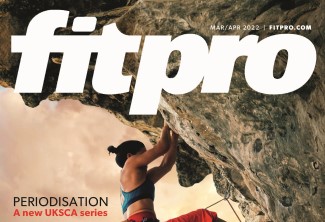Magazine References
Mar – Apr 2022

Pg 6-7 Bike, bus or boots: The benefits of active transportation
References
- Australian Bureau of Statistics Australian Census 2010: abs.gov.au, accessed 15 February 2022.
- Fishman E et al (2015), Adult active transport in the Netherlands: An analysis of its contribution to physical activity requirements, PLoS ONE, 10(4): e0121871. https://doi.org/10.1371/journal.pone.0121871
- Church T et al (2011), Trends over 5 decades in US occupation-related physical activity and their associations with obesity, PLoS ONE, 6(5): e19657.
- Alexander L M et al,The broader impact of walking to school among adolescents: sevenâ€�day accelerometry based study, BMJ, 20053311061–1062.
- Kennedy R et al (2007), Evaluating the effects of a low volume stairclimbing programme on measures of health-related fitness in sedentary office workers, J Sports Sci Med, 6(4): 448-454.
- Holterman A et al (2021), The physical activity paradox in cardiovascular disease and all-cause mortality: the contemporary Copenhagen general population study with 104 046 adults, Eur Heart J, 42(15): 1499-1511. Doi 10.1093/eurheartj/ehab087.
- Evenson K, Wen F (2010), National trends in self-reported physical activity and sedentary behaviors among pregnant women: NHANES 1999-2006, Prev Med Mar, 50(3): 12.
- Zapata-Diomedi et al (2017), A shift from motorised travel to active transport: What are the potential health gains for an Australian city? 11, doi.org/10.137/journal.pone.0184799
- Ratzlaff CR et al (2010), Good news, bad news: sports matter but occupational and household activity really matter – sport and recreation unlikely to be a panacea for public health, Br J Sports Med., 46: 699-701.
Pg 14 – 16 The adaptive nervous system: Exercise enrichment for cognitive resilience
References
- Gelfo F et al (2018), The neuroprotective effects of experience on cognitive functions: Evidence from animal studies on the neurobiological bases of brain reserve, Neuroscience.
- Raichlen DA, Alexander GE (2017), Adaptive capacity: An evolutionary-neuroscience model linking exercise, cognition, and brain health, Trends Neurosci.
- Gallaway PJ et al (2017), Physical activity: A viable way to reduce the risks of mild cognitive impairment, Alzheimer’s disease and vascular dementia in older adults, Brain Sciences.
- Landrigan JF et al (2020), Lifting cognition: A meta-analysis of effects of resistance exercise on cognition, Psychol Res.
- Karssemeijer E et al (2017), Positive effects of combined cognitive and physical exercise training on cognitive function in older adults with mild cognitive impairment or dementia: A meta-analysis, Ageing Research Reviews.
- Voss MW et al (2010), Plasticity of brain networks in a randomised intervention trial of exercise training in older adults, Front. Age Neurosi.
- De la Rosa A et al (2020), Physical exercise in the prevention and treatment of Alzheimer’s disease, J Sport Health Sci.
- Basso JC, Suzuki WA (2017), The effects of acute exercise on mood, cognition, neurophysiology, and neurochemical pathways: A Review, Brain Plast.
Pg 18-20 Understanding carbs
References
- British Dietetic Association. Factsheets. Carbohydrates. Accessed here: https://www.bda.uk.com/resource/carbohydrates.html
- Slavin J et al (2014), Carbohydrates, Adv Nutr., 14, 5(6): 760-1.
- George TW, Paterson E, Waroonphan S, Gordon MH, Lovegrove JA (2012), Effects of chronic consumption of fruit and vegetable puree-based drinks on vasodilation, plasma oxidative stability and antioxidant status, Hum. Nutr. Diet., 25: 477-487.
- WHO (2003) Diet, Nutrition and the Prevention of Chronic diseases. Report of a Joint WHO/FAO Expert Consultation. Geneva: World Health Organization.
- Greenwood et al (2013), Glycemic Index, Glycemic Load, Carbohydrates and Type 2 Diabetes. Systematic review and dose-response meta-analysis of prospective studies. Diabetes Care, 36(12): 4,166-71.
- Ludwig D et al (2014), High Glycemic Index Foods, Overeating and Obesity, Am J Clin Nutr., 100(1): 278-88.
- Chawla S et al (2014), The effect of low-fat and low-carbohydrate diets on weight loss and lipid levels: a systematic review and meta-analysis, Nutrients, 12(12): 3,774.
- Afshin A (2020), Consumption of nuts and legumes and risk of incident ischemic heart disease, stroke and diabetes: a systematic review and meta-analysis, 9, 12(12): 3,774.
- Department of Health (2011), National Diet and Nutrition Survey: Headline Results from Years 1 and 2 (Combined) of the Rolling Programme 2008/9-2009/10
- Nutritics Nutrition Software Analysis.
- Brinkworth G et al (2009), Long-term effects of a very low carbohydrate diet and a low-fat diet on mood and cognitive function, Arch Intern Med., 169(20): 1,873-80.
- Den Besten G et al (2013), The role of short-chain fatty acids in the interplay between diet, gut microbiota and host energy metabolism, J Lipid Res, 54(9): 2,325-40.
- Paoli et al (2013), Beyond weight loss: a review of the therapeutic uses of very-low-carbohydrate (ketogenic) diets, European Journal of Clinical Nutrition, 67: 789-796.
- Phinney SD, Ketogenic diets and physical performance, Nutr Metab. 1, 1(1): 2.
- Lane A et al, Influence of dietary carbohydrates intake on the free testosterone: Cortisol ratio responses to short-term intensive exercise training, Eur J Appl Physiol., 108(6): 1,125-31.
- Howarth K et al (2010), Effect of glycogen availability on human skeletal muscle protein turnover during exercise and recovery, J App Physiol., 109(2): 431-38.
Pg 22-25 Cool it: The science behind cooling for exercise recovery
References
- Allan R, Akin B, Sinclair J, Hurst H, Alexander J, Malone JJ, Naylor A, Mawhinney C, Gregson W, Ihsan, M (2021), Athlete, coach and practitioner knowledge and perceptions of post‑exercise cold‑water immersion for recovery: a qualitative and quantitative exploration, Sport Sciences for Health, https://doi.org/10.1007/s11332-021-00839-3
- Ihsan M, Watson G, Abbiss CR (2016), What are the Physiological Mechanisms for Post-Exercise Cold Water Immersion in the Recovery from Prolonged Endurance and Intermittent Exercise? Sports Med.,46:1,095-1,109. https://doi.org/10.1007/s40279-016-0483-3
- Herrera E, Sandoval MC, Camargo DM, Salvini TF (2010), Motor and sensory nerve conduction are affected differently by ice pack, ice massage, and cold water immersion, Phys Ther., 90(4): 581–591. https://doi.org/10.2522/ptj.20090131
- Malta ES, Dutra YM, Broatch JR, Bishop DJ, Zagatto AM (2021), The effects of regular cold-water immersion use on training-induced changes in strength and endurance performance: a systematic review with meta-analysis, Sports Med. 51(1): 161-174. doi: 10.1007/s40279-020-01362-0. PMID: 33146851.
- Bouzigon R, Dupuy O, Tiemessen I, De Nardi M, Bernard J-P, Mihailovic T, Theurot D, Miller ED, Lombardi G and Dugué BM (2021), Cryostimulation for Post-exercise Recovery in Athletes: A Consensus and Position Paper, Sports Act. Living,3:688828. doi: 10.3389/fspor.2021.688828
- Grainger A, Malone J, Costello JT, Bleakley CM and Allan R (2021), The BASES Expert Statement on the use of cooling therapies for post exercise recovery, The Sport and Exercise Scientist, 70: 8-9.
Pg 30-32 Periodisation – what’s it all about?
References
- Gamble P (2013), Strength and conditioning for team sports: Sport-specific physical preparation for high performance, Routledge, Jan 25.
- Haff GG (2016), The essentials of periodisation. Strength and Conditioning for Sports Performance, 406.
- Dubois R, Paillard T, Lyons M, McGrath D, Maurelli O, Prioux J (2017), Running and metabolic demands of elite rugby union assessed using traditional, metabolic power, and heart rate monitoring methods, Journal of Sports Science & Medicine, 16(1): 84.
- Duhig S, Shield AJ, Opar D, Gabbett TJ, Ferguson C, Williams M (2016), Effect of high-speed running on hamstring strain injury risk, British Journal of Sports Medicine, 50(24): 1,536-40.
- Cunanan AJ, DeWeese BH, Wagle JP, Carroll KM, Sausaman R, Hornsby WG, Stone MH (2018), The general adaptation syndrome: A foundation for the concept of periodization, Sports Medicine, 48(4): 787-797.
- Ravé G, Granacher U, Boullosa D, Hackney AC, Zouhal H (2020), How to Use Global Positioning Systems (GPS) Data to Monitor Training Load in the ‘Real World’ of Elite Soccer, Frontiers in Physiology, 20, 11: 944.
- Lambert MI, Borresen J (2010), Measuring training load in sports, International journal of sports physiology and performance, 5(3): 406-11.
- Hawley JA (2008), Specificity of training adaptation: time for a rethink?, The Journal of Physiology, 586 (Pt 1):1.
- Bishop PA, Jones E, Woods AK (2008), Recovery from training: A brief review, The Journal of Strength & Conditioning Research, 22(3): 1,015-24.
- Jeffreys I (2005), A multidimensional approach to enhancing recovery, Strength and Conditioning Journal, 27(5): 78.
- Turner A, Comfort P (2017), Periodisation, In Advanced Strength and Conditioning(pp 116-136). Routledge.
- Haff GG (2019), 14 periodisation strategies for young athletes, Strength and Conditioning for Young Athletes: Science and Application, 281.
- Issurin VB (2010), New horizons for the methodology and physiology of training periodization, Sports Medicine, 40(3): 189-206.
- Kiely J (2012), Periodisation paradigms in the 21st century: Evidence-led or tradition-driven?, International Journal of Sports Physiology and Performance, 7(3): 242-250.
- Issurin VB (2016), Benefits and limitations of block periodized training approaches to athletes’ preparation: A review, Sports Medicine, 46(3): 329-338.
- Naclerio F, Moody J, Chapman M (2013), Applied periodization: A methodological approach, Journal of Human Sport and Exercise, 8(2): 350-366.
- Kiely J (2018), Periodization theory: Confronting an inconvenient truth, Sports Medicine, 48(4): 753-764.
- Stone MH (2003), Periodization Strategies, Strength and Conditioning Journal.


